along a meridian to Cistercian abbeys
530 km to the south, almost on the same meridian is the oldest known analemmatic sundial in Brou, a quarter of Bourg en Bresse in France.
In between, not so far from the meridian, left and right there are important remains of medieval Cistercian abbeys including Orval, Clairvaux, Fontenay and Cîteaux. Interesting cities in the area are Reims, Troyes and Beaune.
A group of friends from Herkenrode, also a former Cistercian abbey, did its fifteenth annual trip to Cistercian Abbeys in Europe in September 2017 under the slogan “From sundial to sundial along a meridian to Cistercian abbeys"
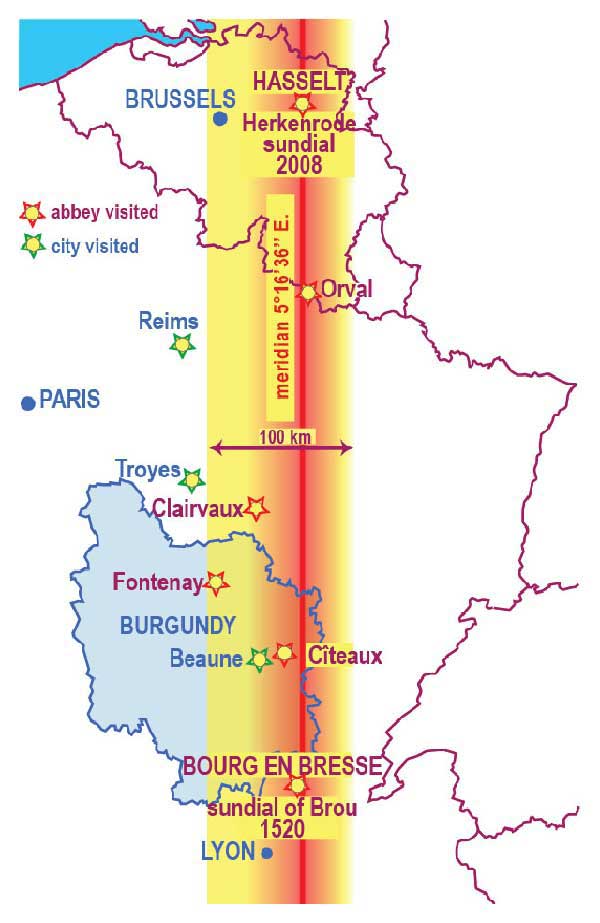
Reims and Troyes
Since the baptism of Clovis in 498 there were crowned about all French kings.
Their names and the coronation dates, with as last Charles X in 1825, can be read on the triangular plane of the oddly shaped sundial on Rue Chanzy, 300 meters south of the world-famous cathedral.
Artist Christian Renonciat made it in cast iron in 1991 and the admittedly immobile shape refers to a portable sundial that balancing seaks its horizontal position.
A rectangular triangle indicates the hour with the shadow of his hypotenuse. Hour lines have been installed on the square. They continue on a vertical wall, but they diverge further instead of meeting together in one point as it should be.
The artist conceived himself how to do it without the help of a sundial expert. He was wrong.
The same day it was going to Troyes. There, in the library is the largest collection of manuscripts from the Cistercian abbey of Clairvaux, written since its foundation in 1115.
Troyes, with its numerous half-timbered houses, passes for the most beautiful medieval town in France. On the chapel of the hôtel-Dieu, formerly a hospital, there is a special version of a sundial.
The light of the sun falls on the wall through a hole, an oculus, in a plate placed in the right place. The light spot indicates the hour and the date on a fine-mesh grid of hour and date lines, an hour line every 5 minutes and three or four date lines per month. The dates correspond to those on an equation of time loop in the form of a eight.
The equation of time is, as is known, the difference between the average solar time and the actual solar time or true local time and, depending on the date, has a value ranging from about minus a quarter of an hour to plus a quarter of an hour.
A smaller model of a similar sundial is placed higher.
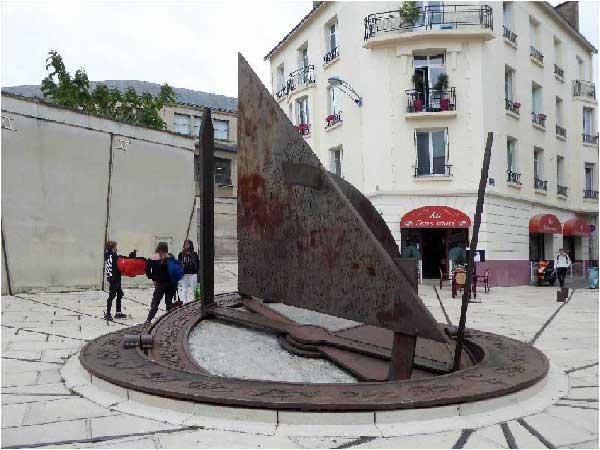
The sundial at the rue Chanzy in Reims
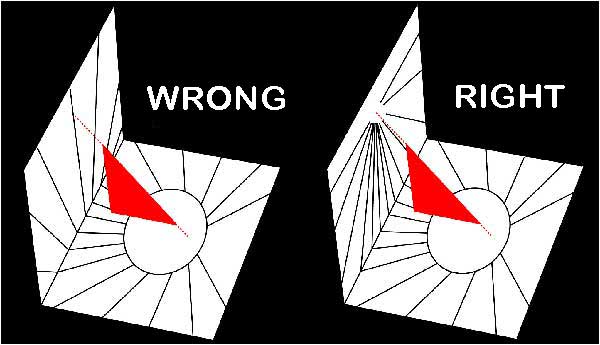
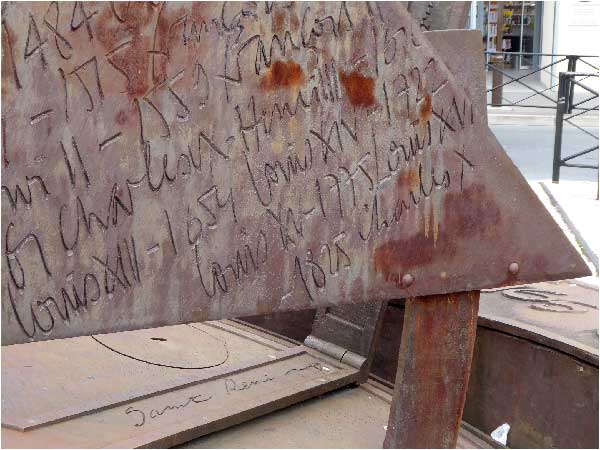
The names and coronation dates of the French kings on the sundial
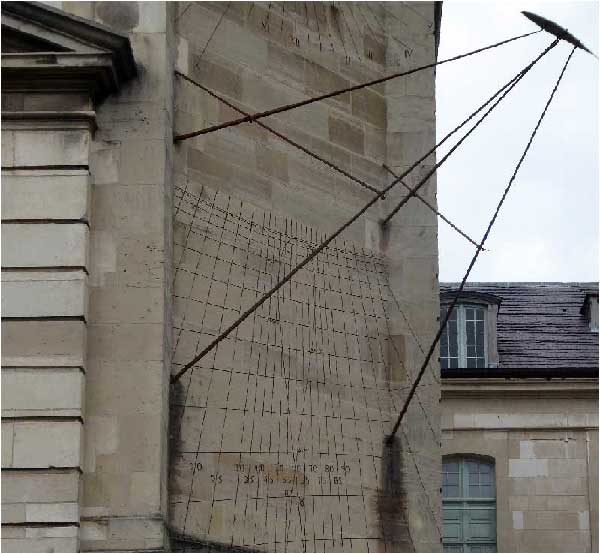
The sundials at the hôtel-Dieu in Troyes
The Cistercian abbeys of Clairvaux and Fontenay
After the French Revolution abbeys and monasteries were abolished around 1800. From 1808 until a few years ago the historic buildings of Clairvaux served as a prison. They are now being restored.
There is a simple sundial on the enclosure wall. At the entrance of a building two small sundials are engraved into the wall. They may date from the time of the destination as a prison.
The style is missing, he probably stabbed perpendicularly in the wall and was therefore not a pole style. The hour line pattern is symmetrical as with a southerly pointed sundial although the walls have an orientation that deviates about 20 degrees from the south.
The hour-line pattern shows the same angles between the hour lines, although on the latitude of Clairvaux, this must be different , at a south facing sundial between 5 and 6 hours more than twice as large as between 11 and 12 hours.
For a prisoner with a long term detention, the right hour is apparently not so important!
The abbey of Fontenay from 1118, the next in the series, is the most complete, the best preserved and purest of style of all Cistercian abbeys. With the extension of the order, the floor plan of this abbey served as a model so that all the abbeys became the same lay-out as Bernardus had described.
Since 1981 she is on the heritage list of UNESCO.
Although there may have been a sundial once, there is no sign of it now.
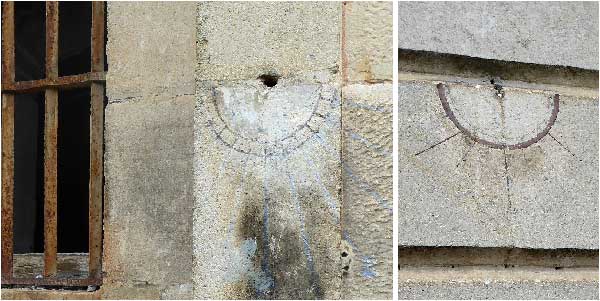
The two little sundials at the abbey of Clairvaux
The little town Beaune
A bell tower has been erected in Beaune by the Cistercians of the nearby abbey of Maizières and next to it there is a permanent exhibition of works by the surrealist artist Salvator Dali.
At the Place Fleury, 150 m from the hôtel-Dieu there is a sundial on a façade. The house is called 'Au cadran solaire' (in the sundial) which is painted in large letters on the cornice. However, it is so wide that it casts a shadow on the sundial and no hour can be read.
Surrealistic too!
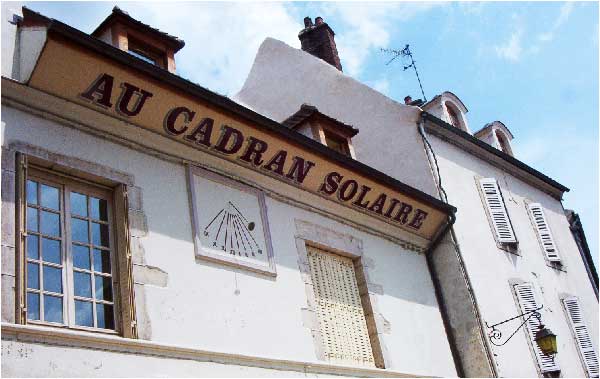
Bourg en Bresse
The sundial of Brou
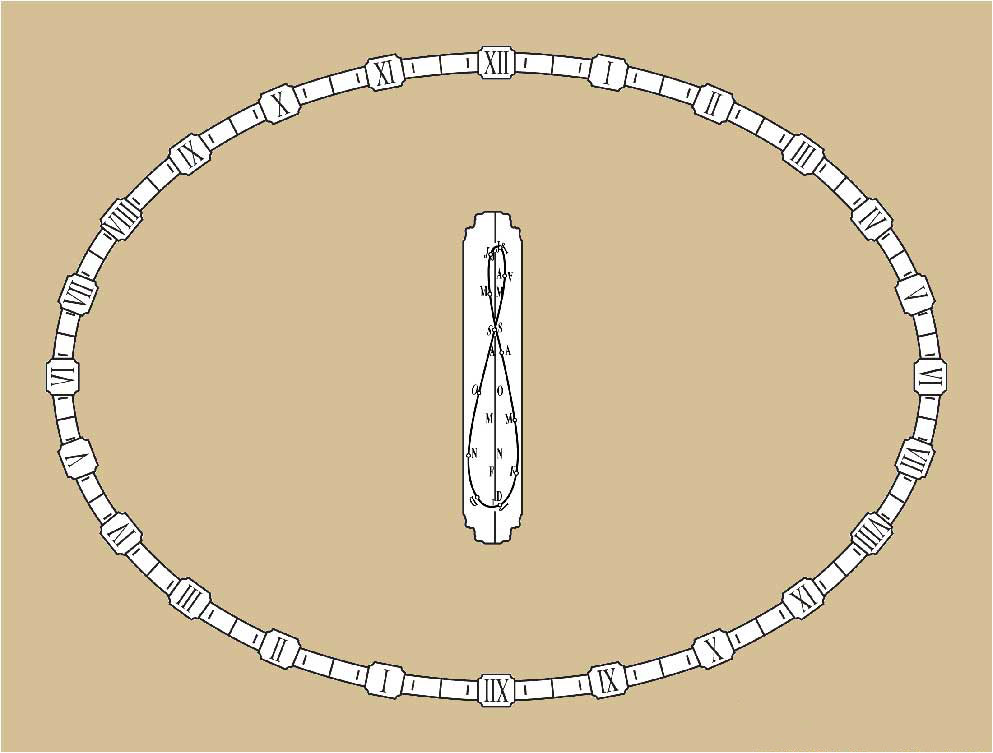
The ground plan of the sundial of Brou (calculated with the fomulas of de Lalande)
The church and the monastery he belongs to, make the visit even more worthwhile. They were declared by the French in 2014 as their chosen heritage monument. Also for Flemings, once ruled from Mechelen (Belgium) by Magaretha of Austria, the aunt of the still too young Emperor Charles, they have a special meaning. For the tomb of her late husband, for that of her mother-in-law and for her own, in Brou she had converted a small priory into an Augustinian monastery and a flamboyant-Gothic church. The best Flemish architects and craftsmen worked here from 1513 to 1532.
The sundial before the church dates from the period of the construction of the church, to indicate the working hours for the builders. Jérôme de Lalande (1732-1807) astronomer from Bourg en Bresse, but mainly active in Paris, restored the sundial. Instead of in glazed brick, he executed it in freestone.
De Lalande was the first to find the mathematical formulas that lie behind the sundial. It was the most difficult task in connection with sundials he ever performed, he said himself. He described the formulas in 1757 in a document for the Académie des Sciences. Yet it is admirable that scientists from the time of Margeretha of Austria, 200 years earlier, already possessed the knowledge, be it graphic and not mathematical, to design such a sundial.
The sundial is elliptical, executed horizontally, on the ground. The object that gives the shadow is perpendicular and is moved over a date scale, a sort of calendar. Until recently this was a standard on a tripod but it is no longer there. You must, like 500 years ago, just stand on the date scale on the date of the day and then your shadow indicates the hour on the hour stones of the ellipse. Although there is no sun at night and no hour can be read, the night hours are indicated. Thus the ellipse is complete with 24 hour indications.
The date scale is oriented north-south and besides the dates there is an eight-shaped equation of time loop (in red on the drawing). It is not mentioned in a description of 1836. It was installed in 1902 when the sundial was restored after storm damage and the contractor, a sundial enthusiast, took the initiative.
That loop is based on the difference throughout the year between the average solar time and the actual solar time. The value of this difference is not indicated and the wrong opinion arises that you have to stay on this eight form. The correct location is on the short axis at the level of the date.
The relationship between the dimensions of the ellipse and of the hour and date indications depends on the selected size of the ellipse, the latitude of the place and the declination of the sun on the chosen date, according to the formulas Jérôme de Lalande already recorded .
Various authors (Rousselet, Rohr) indicate the dimensions of the sundial (long axis, short axis and length of the date scale) differently. Never the proportions between their measurements are in accordance with the calculations on the basis of the mathematical formulas. These dimensions must be in Brou (latitude 46.2 ° N.B.) as 1000/722/300.
A land surveyor will have to measure the sundial that measures 10 to 11 meters as the largest measure.
In 1644 the French mathematician Jean-Louis Vaulezard gave the name 'analemmatic' to this type of sundial. The name is derived from the Greek ana (top) and lemma (recording) and thus means 'look from top' or top view. If you look at a spherical equatorial sundial (hoop sundial) from above, you see the elliptical pattern of an analemmatic sundial.
In 1836, when Augustine P. Rousselet described the sundial in his book 'Histoire et description de l'église de Brou' ( link pages 149 to 154 - read as 'Google book') there was from this type of sundial only an implementation in Brou.
When the group from Herkenrode left the place after the visit to the church and the monastery, they saw a German car on the sundial with in the open door a festively dressed Muslim women from a wedding feast. She probably did not know that she was parked by car on a 500-year-old monument of gnomonics.
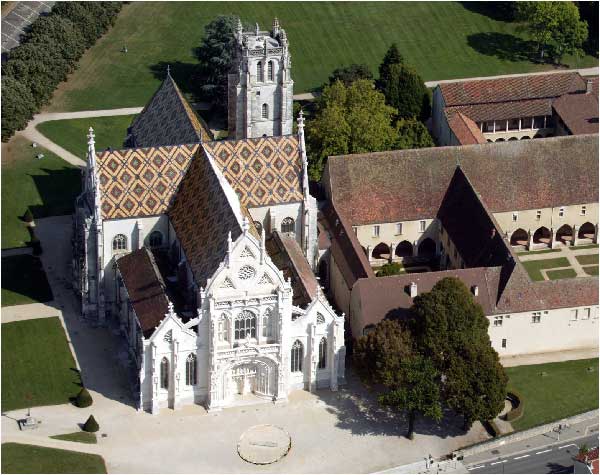
Church and monastery of Brou with on the square before the church, the sundial
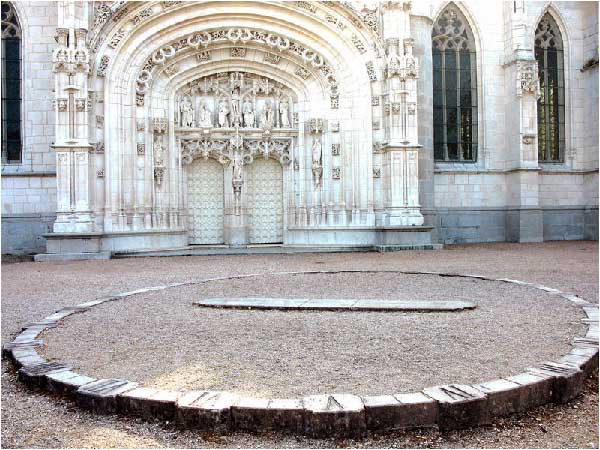
Te sundial of Brou on the square before the church

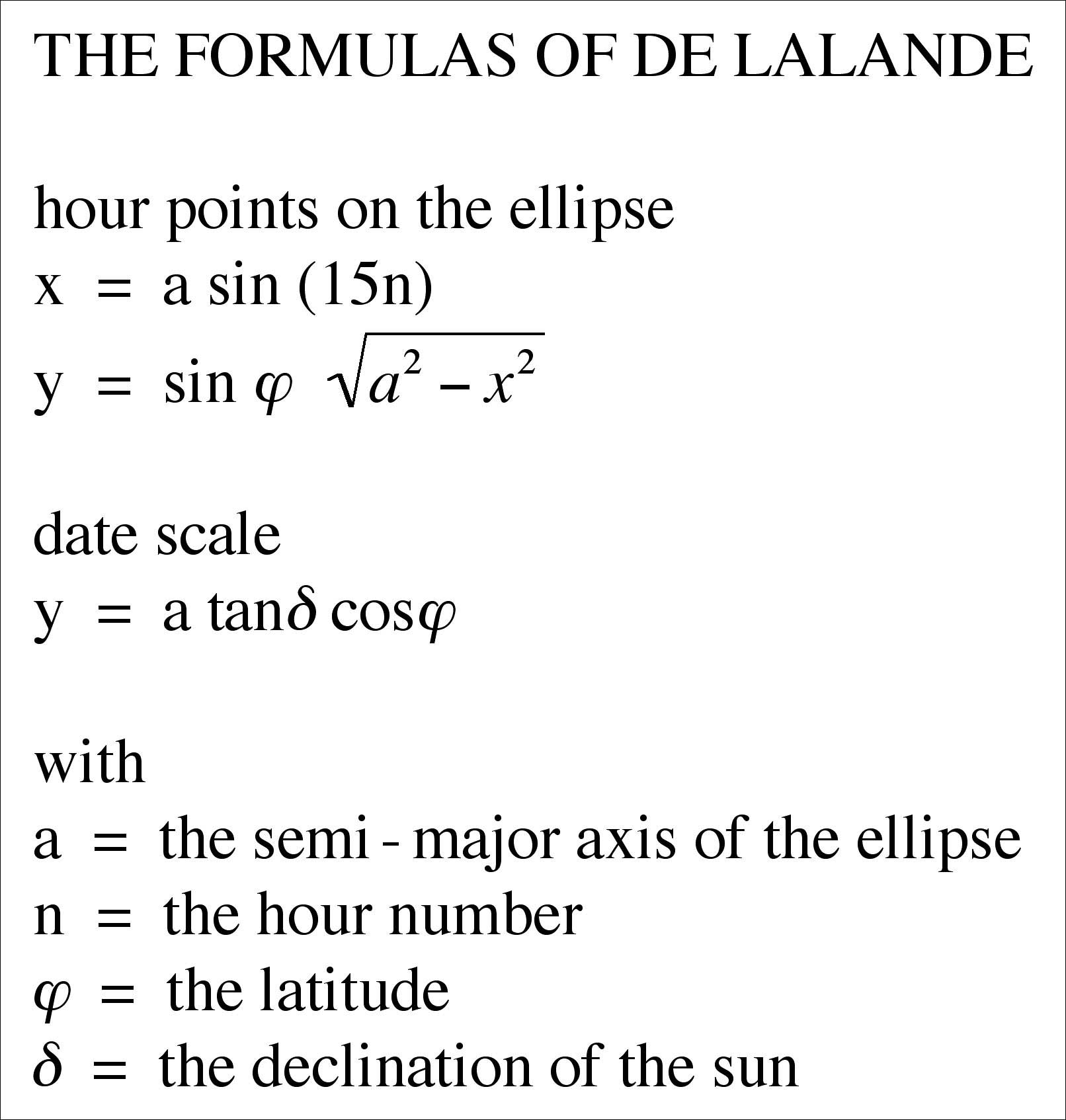
Date scale and the formulas of de Lalande
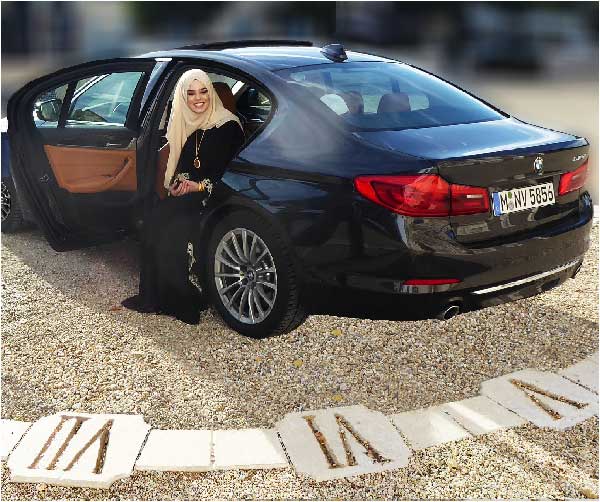
Parking on a 500-year-old monument of gnomonics
The abbeys of Cîteaux, Orval and Herkenrode
Only three buildings from the past remain and in 1998, on the 900th anniversary of the order, a new church and a new, re-inhabited abbey were inaugurated. However, a sundial can not be found.
The trip back went through the abbey of Orval, just past the Belgian border. Here too there is, next to the ruins of the abbey founded in 1132 a new and again inhabited abbey from 1948. But also no sundial. Well the fruity Trappist beer.
The journey ended where she started, in the abbey of Herkenrode in Hasselt, where impressive buildings bear testimony to the largest and richest Cistercian women's abbey in the lowlands.
It was founded in 1192 and is now connected to its sister abbeys from the beginning of the order along one meridian and with special sundials between her analemmatic sundial and the oldest known of this kind, the sundial of Brou.
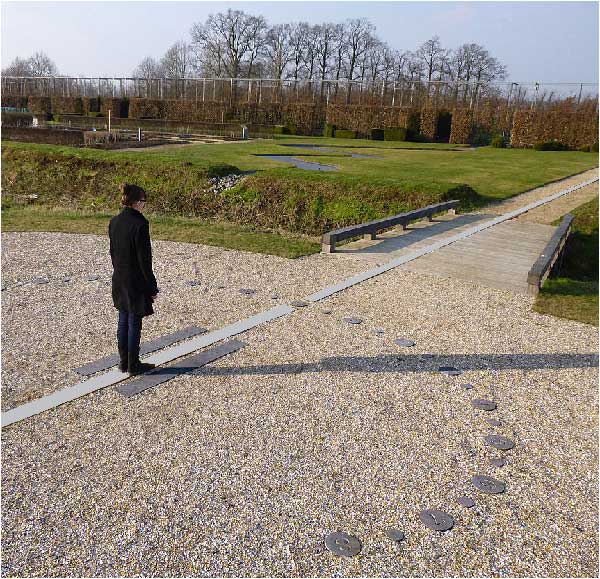
The sundial and the meridian in Herkenrode
Bibliography
- René R.J Rohr, Cadrans solaires: histoire, théorie, pratique. Traité de gnomonique, 1986